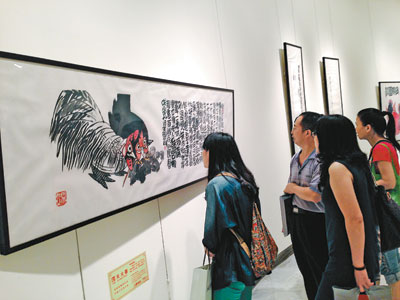
Anna Zhao
anna.whizh@yahoo.com
MORE than 60 freehand brushwork paintings by Chinese artist Wang Hanshan (1924-2000) are on exhibition in commemoration of the artist’s 90th birthday at Guan Shanyue Art Museum until Aug. 31.
The paintings, created by Wang during the 1990s when the artist was in his prime, are mostly flower and bird paintings with strong traditional water and ink style influences.
Wang, a native of Shuangfeng County in Hunan Province, was influenced by the unique cultural climate in the area that boasts a strong scholar tradition.
Wang lived a simple life and shied away from wealth and fame, but he had passion and enthusiasm for art. He learned painting from traditional Chinese painting masters Gao Xixun and Pan Tianshou. While adhering to a strong heritage of traditional literati paintings, Wang was skillful in developing his own style by translating his life experiences into the genre of freehand brush painting.
Wang once said his life was divided into three areas — 20 percent was devoted to writing, 20 percent to painting and 60 percent to reading.
His paintings often embodied his pursuit of artistic excellence through simple animal figures and memories. For example, his portrayal of frogs, fish, bulls and eagles were associated with rural life at different times.
Wang’s paintings, most of which featured ordinary objects in life, showcased his temperament and his affection for pastoral life.
As an artist who drew the nutrients of his creative blood from folk life, Wang was good at seeking inspirations from folklore, and his paintings were always accompanied by lyrics or poems that told ancient stories closely related to rural life.
In a painting of a bullfight, Wang cited a folk story of a famous painter who had wrongly painted two fighting bulls — the bulls’ wagging tails should have been tightly clamped under their legs.
Wang was the first modern painter whose works were preserved in the Palace Museum, and he was also one of the modern artists whose works were abundantly collected by the National Art Museum of China.
Scholar Wang Luxiang, who is also the exhibition’s curator, said Wang was successful in distinguishing himself from other literati painting artists by infusing folk culture into his artistic creations so that subjects under his brushes seem to have assumed humanistic spirits. “I think that there are three masters of freehand brush paintings in modern China — Qi Baishi, Pan Tianshou and Wang Hanshan. While Qi integrated literati paintings with folk art and Pan excelled at literati paintings, Wang had walked further by giving his subjects humanistic expressions,” Wang said.
Artist Zhang Ding, who is renowned for his achievements in multiple fields in art, said Wang’s works integrated four characteristics into one: his love for rural nature, his profound scholar knowledge, his ingenuity in painting and his ability to project magnificent grandness from small objects.
Dates: Until Aug. 31
Hours: 9 a.m.-5 p.m., closed Mondays
Entrance fee: Free
Venue: Guan Shanyue Art Museum, 6026 Hongli Road, Futian District (福田区红荔路6026号关山月美术馆)
Metro: Longhua or Longgang Line, Children’s Palace Station (少年宫站), Exit B
|

